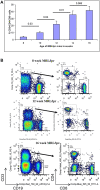Double negative T cells, a potential biomarker for systemic lupus erythematosus
- PMID: 32257532
- PMCID: PMC7093895
- DOI: 10.1093/pcmedi/pbaa001
Double negative T cells, a potential biomarker for systemic lupus erythematosus
Abstract
Systemic lupus erythematosus (SLE) is an autoimmune disease that is a challenge to diagnose and treat. There is an urgent need for biomarkers to help define organ involvement, and more effective therapies. A unique population of T cells, the CD3+CD4-CD8- (DNeg) cells, is significantly increased in lupus patients. Twenty-seven cases (53%) of pediatric SLE patients had elevated DNeg cells in their peripheral blood, which correlated with kidney function (R2 = 0.54). Significant infiltration of DNeg cells was observed in both adult and pediatric lupus kidneys by immunofluorescence. For the first time, this study provides direct evidence that DNeg cells facilitate kidney injury in preclinical 8-week-old MRL/lpr lupus mice. In lupus mice, the increase in DNeg cells tracked with worsening disease and correlated with kidney function (R2 = 0.85). Our results show that DNeg cells per se can cause kidney dysfunction, increase in number with increase in disease pathology, and could serve as a potential biomarker.
Keywords: CD3+CD4−CD8− T cells; glomerulonephritis; inflammation; lupus.
© The Author(s) 2020. Published by Oxford University Press on behalf of West China School of Medicine & West China Hospital of Sichuan University.
Figures





Similar articles
-
Nicotinamide alleviates kidney injury and pregnancy outcomes in lupus-prone MRL/lpr mice treated with lipopolysaccharide.Biochem Biophys Res Commun. 2019 Mar 19;510(4):587-593. doi: 10.1016/j.bbrc.2019.01.110. Epub 2019 Feb 7. Biochem Biophys Res Commun. 2019. PMID: 30739788
-
Repeated 0.5-Gy gamma irradiation attenuates autoimmune disease in MRL-lpr/lpr mice with suppression of CD3+CD4-CD8-B220+ T-cell proliferation and with up-regulation of CD4+CD25+Foxp3+ regulatory T cells.Radiat Res. 2008 Jan;169(1):59-66. doi: 10.1667/RR1013.1. Radiat Res. 2008. PMID: 18159952
-
Glomerular Injury Is Exacerbated in Lupus-Prone MRL/lpr Mice Treated with a Protease-Activated Receptor 2 Antagonist.Tohoku J Exp Med. 2019 Oct;249(2):127-133. doi: 10.1620/tjem.249.127. Tohoku J Exp Med. 2019. PMID: 31666446
-
Effects of 1,25(OH)2 D3 and vitamin D receptor on peripheral CD4+ /CD8+ double-positive T lymphocytes in a mouse model of systemic lupus erythematosus.J Cell Mol Med. 2017 May;21(5):975-985. doi: 10.1111/jcmm.13037. Epub 2017 Jan 7. J Cell Mol Med. 2017. PMID: 28063200 Free PMC article.
-
Effects of FTY720 in MRL-lpr/lpr mice: therapeutic potential in systemic lupus erythematosus.J Rheumatol. 2002 Apr;29(4):707-16. J Rheumatol. 2002. PMID: 11950011
Cited by
-
LangChuangHeJi decoction ameliorates lupus via preventing accumulation of CD138+ T cells in MRL/lpr mice.Am J Transl Res. 2021 Nov 15;13(11):12440-12460. eCollection 2021. Am J Transl Res. 2021. PMID: 34956465 Free PMC article.
-
Dietary Supplementation With Eicosapentaenoic Acid Inhibits Plasma Cell Differentiation and Attenuates Lupus Autoimmunity.Front Immunol. 2021 Jun 15;12:650856. doi: 10.3389/fimmu.2021.650856. eCollection 2021. Front Immunol. 2021. PMID: 34211460 Free PMC article.
-
Enterogenous Microbiotic Markers in the Differential Diagnosis of Crohn's Disease and Intestinal Tuberculosis.Front Immunol. 2022 Mar 16;13:820891. doi: 10.3389/fimmu.2022.820891. eCollection 2022. Front Immunol. 2022. PMID: 35371004 Free PMC article.
-
Nonspecific increase of αβTCR+ double-negative T cells in pediatric rheumatic diseases.World J Pediatr. 2024 Dec;20(12):1283-1292. doi: 10.1007/s12519-024-00854-7. Epub 2024 Nov 28. World J Pediatr. 2024. PMID: 39604769 Free PMC article.
-
Examining the Relationship between Circulating CD4- CD8- Double-Negative T Cells and Outcomes of Immuno-Checkpoint Inhibitor Therapy-Looking for Biomarkers and Therapeutic Targets in Metastatic Melanoma.Cells. 2021 Feb 16;10(2):406. doi: 10.3390/cells10020406. Cells. 2021. PMID: 33669266 Free PMC article.
References
Grants and funding
LinkOut - more resources
Full Text Sources
Research Materials
